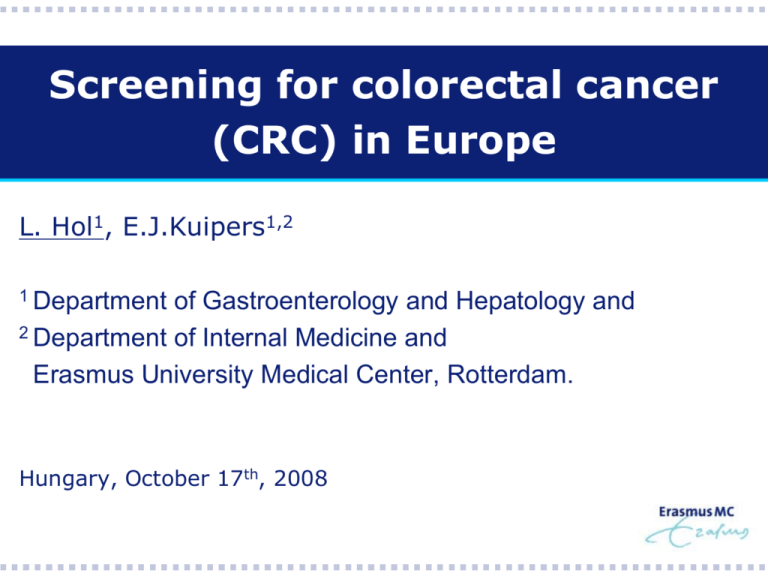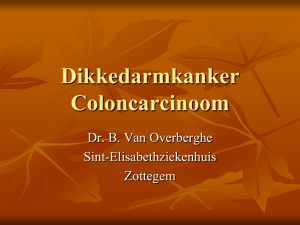CRC Screening in Europe
advertisement

Screening for colorectal cancer (CRC) in Europe L. Hol1, E.J.Kuipers1,2 1 Department of Gastroenterology and Hepatology and 2 Department of Internal Medicine and Erasmus University Medical Center, Rotterdam. Hungary, October 17th, 2008 CRC Screening in Europe Nation-wide screening Colorectal cancer is the most common malignancy (380,000/year) and the second most common cancer related death (180,000/year) in Europe CRC mortality varies over countries, with Hungary having the highest mortality rates in Europe and Greece having the lowest CRC Screening in Europe Nation-wide screening Screening can reduce CRC mortality due to detection of early carcinomas and removal of pre-malignant lesions1,2 1Winawer, NEJM 1993; 2Ries LAG 2007; CRC Screening in Europe Screening options 1. Guaiac-based FOBT (gFOBT) 2. Immunochemical FOBT (FIT) 3. Flexible sigmoidoscopy (FS) 4. Colonoscopy CRC Screening in Europe Guaiac-based FOBT Study Age range mortality Nottingham1 45-75 13% 11 years Funen2 45-74 11% 17 years Minnesota3 50-80 21% 18 years Goteborg4 60-64 16% 15.5 years 1Mandel JS, NEJM 1993; 2Kronborg O, Lancet 1996; 3Hardcastle JD, Lancet 1996; Kewenter, Scan J Gastroenterol 1994 FOBT Performance Characteristics Positivity Rate Specificity (Neoplasia) Sensitivity (CRC) Hemoccult II1 2.5 98.1 37.1 Heme Select2 5.9 95.2 68.8 OC-Hemodia3 6.5 94.0 88.9 *In a screening-naïve population; ** Estimated specificity and sensitivity 1Petrelli N, Surg Oncol 1994; 2Allison JE, NEJM 1996; 3Nakama H, Eur J Cancer 2001 Sigmoidoscopy screening Two case-control studies demonstrated a 60-80% mortality1,2 Country Population Age-group UKFlex3 UK 354262 55-64 SCORE4 Italy 236.568 55-64 PLCO5 USA 77 465 55-74 Norway 20780 50-64 NORCCAP6 1 Selby, NEJM 1992; Newcomb NEJM 1992 Lancet 2002; 4Segnan, JNCI 2002; 5Weissfeld, JNCI 2005; 6Gondal Sacn J G 2003 3UKflex, CRC Screening in Europe Colonoscopy screening 1Winawer, NEJM 1993; CRC Screening in Europe Nation-wide screening European health council has recommended CRC screening for average-risk persons aged ≥ 50 years old with any test6 Today, more than 50% of the target population in the European Union is however offered no screening at all Nation-wide screening programs in European countries vary widely in strategy and quality guidelines are lacking, hereby hampering efficacy 6Commission of the European Communities Brussels, 2003 CRC Screening in Europe Brussel declaration • Set up an European action plan. • Provide European health ministers with an European guideline for CRC screening. • Include practical assistance in the detection and management of highrisk groups. • Include a demand for provision of all target groups with adequate information. • Implement any national screening programme using call/recall system through a central agency. • Implement any national screening programme based on qualityassured and quality-controlled infrastructure. • Advise the member states to facilitate the provision of appropriate training to personnel involved in screening, processing of results and subsequent treatment. • Establish and fund designated research programmes for the development and evaluation of programmes for CRC screening. 7International union against cancer. Brussel guidelines 2007 CRC Screening in Europe Brussel declaration • Set up an European action plan. • Provide European health ministers with a European guideline for CRC screening. • Include practical assistance in the detection and management of highrisk groups. • Include a demand for provision of all target groups with adequate information. • Implement any national screening programme using call/recall system through a central agency. • Implement any national screening programme based on qualityassured and quality-controlled infrastructure. • Advise the member states to facilitate the provision of appropriate training to personnel involved in screening, processing of results and subsequent treatment. • Establish and fund designated research programmes for the development and evaluation of programmes for CRC screening. 7International union against cancer. Brussel guidelines 2007 CRC Screening in Europe Nation-wide screening (call/recall) CRC Screening in Europe Opportunistic programs CRC Screening in Europe Regional programs CRC Screening in Europe Pilot programs CRC Screening in Europe Nation-wide program (call/recall) Country Test Interval Age Participation England gFOBT Biennial 60-69 50-70% Scotland gFOBT Biennial 50-74 CRC Screening in Europe Nation-wide program (opportunistic) Country Test Interval Age Participation Austria gFOBT Sigmoidoscopy Colonoscopy Annual Biennial 5-yearly 10-yearly 50-55 ≥ 55 ≥ 55 ≥ 55 Czech gFOBT / FIT Biennial ≥ 50 <50% Germany gFOBT 50-55 ≥ 55 ≥ 55 <20% Colonoscopy Annual Biennial 10-yearly Poland Colonoscopy 10-yearly ≥ 50 <10% Slovakia Colonoscopy 10-yearly ≥ 50 <30% CRC Screening in Europe Regional programs Country Test Interval Age Coverage Finland gFOBT Biennial 60-69 France gFOBT Biennial 50-74 30-51% Italy FIT Sigmoidoscopy Both Biennial 5-yearly ≥ 50 ≥ 50 15-70% Introduction (I) Pilot program in the Netherlands 2001 Dutch Health council: CRC screening should be considered. 2006 Start pilot studies 2008 Dutch Health council: Nation-wide CRC screening program most likely based on FIT will be introduced in the Netherlands in 2010. Studies on endoscopic screening are needed Introduction (II) Aim Primary aim To determine the attendance rate of guaiac based faecal occult blood test (gFOBT), immunochemical FOBT (FIT) and flexible sigmoidoscopy (FS) for CRC screening. Secondary objective To determine the detection rate of advanced neoplasia and colorectal carcinoma of the three screening tests Methods (I) CORERO-trial Time frame November 2006 – November 2007 Design Population based Randomised trial Randomisation Prior to invitation Per household Inclusion Average risk men/women Screening naïeve Aged 50-75 years old Results (I) Trial profile gFOB 5004Twere invited FIT FS 5007 were invited 5000 were invited 164 were excluded 206 were excluded 300 were excluded 4748 were eligible 4843 were eligible 4700 were eligible 2374 (50%) attended 2979 (62%) attended 1522 (32%) attended Results (II) Attendance: men / women % 100 Men Women 80 P<0.001 60 P<0.001 40 P=0.01 20 0 46 52 59 64 34 31 gFOBT FIT FS Univariate analysis Results (III) Findings n (%) gFOBT FIT FS* 2351 2975 1386 Positive screening 65 (2.8) 143 (4.8) 142 (10.2) Colonoscopy 62 (95) 137 (96) 141 (99) Non-neoplastic polyp 4 (0.2) 7 (0.2) 271 (19.6) Non-advanced adenoma 9 (0.4) 18 (0.6) 172 (12.4) Advanced adenoma 25 (1.1) 64 (2.2) 112 (8.1) CRC 6 (0.3) 14 (0.5) 8 (0.6) Completed screening Detection rate / 100 screened * Findings during sigmoidoscopy and colonoscopy; Advanced adenoma: adenoma ≥ 10 mm, villous component (≥ 25% villous) or high-grade dysplasia; serrated adenoma; three or more adenomas. Results (V) Advanced neoplasia per 100 invited P<0.001 3,0 3.0 2.6 2,5 2.5 P<0.001 2.0 2,0 1.6 1.5 1,5 1.0 1,0 0.7 0.5 0,5 0.0 0,0 gFOBT FIT FS Conclusion (II) Conclusie Summary CORERO-trial FIT screening should be preferred over guaiacbased FOBT screening Sigmoidoscopy screening seems to be most effective, but RCTs have to be awaited to determine the CRC incidence and mortality reduction due to FS screening CRC Screening in Europe Main issues of CRC screening in Europe • Quality assurance (European guidelines) • Uptake / coverage • Endoscopy resources CRC Screening in Europe Quality assurance Four out of ten nation-wide programs do not have national guidelines for CRC screening European guidelines are currently being made (IARC) - Organisation - Evaluation and interpretation of screening outcomes - Quality assurance for endoscopy - Professional requirements and training - Quality assurance for pathology - Management of screen detected lesions - Surveillance CRC Screening in Europe Uptake / coverage Uptake of CRC screening is generally low High attendance is a prerequisite for an effective colorectal cancer (CRC) screening program A recall system is preferable over opportunistic screening7 7International union against cancer. Brussel guidelines 2007 CRC Screening in Europe Public awareness Willingness to be screened depends on awareness of colorectal cancer and CRC screening A survey among people in the target population in 21 European countries showed8 • 51% had knowledge of CRC screening • 75% were 'very', or 'quite interested’, in taking up faecal occult blood (FOB) screening if offered free • Lack of awareness of risk (31%) was a main barrier to CRC screening 8Keighley M, Eur J Cancer Prev 2004 CRC Screening in Europe Endoscopy resources No solid data on endoscopy resources in Europe Endoscopy capacity varies per region9,10,11 Required resources depend on • Target population • Screening test (positivity rate) • Screening interval • Attendance rate • Guidelines for surveillance 9Ladabaum U, Gatroenterol 2005, 10Butterly L, Am J Prev Med 2007, 11Seeff LC, Gastroenterol 2004 CRC Screening in Europe Positivity rate Cut-off % Positive Grazzini, 2004 100ng 5.8 Segnan, 2005 100ng 4.6 Segnan, 2007 100ng 4.7 Guittet, 2007 75ng 2.4 Van Rossum, 2008 100ng 5.5 Hol, 2008 100ng 4.8 CRC Screening in Europe Colonoscopy resources Colonoscopies per 100.000/invitees 6000 5000 4000 FIT IFobt(2yr) (2 jr) gFOBT Gfobt (2yr) 3000 Sigmo (5 jr) Sigmo (5yr) Colonoscopie Colono (10yr) 2000 1000 0 2005 2006 2007 2008 2009 2010 2011 2012 2013 2014 2015 2016 2017 2018 2019 2020 2021 2022 2023 2024 2005 2010 2015 2020 2025 Year CRC Screening in Europe Conclusie Conclusions 1. Several initiatives for CRC screening in Europe 2. Only one country with a nation-wide screening program (call / recall system) 3. European guidelines will be available in 2009 4. European countries should collaborate for further improvement of CRC screening quality CORERO-trial The team Steering Committee Ernst Kuipers Dik Habbema Monique van Leerdam Marjolein van Ballegooijen Hanneke van Vuuren Sandra van der Togt Jaqueline Reijerink Lieke Hol Gastroenterology Lab Angela Heijens Jan Francke Martine Ouwendijk Nicolle Nagtzaam Endoscopy unit Jelle Haringsma Maurice Laban Advisory board Mrs. I. Joung Mrs. A. Cats J.W. Coebergh
